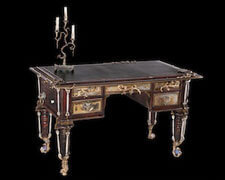
“Even as a new desk, in its day, this was a modest item of furniture, a place for a man to work, and yet possessing a noble honesty,” stated Brazier-Jones. “I wanted to keep the desk complete and intact, to save all its scars and broken varnish, this history alive with its gnarled textures…I decided to attach, via callipers and clasps the necessaries to regain functionality. To this I have also embroidered imagery appropriate to the great man’s inspirations and imaginings. I visualize Stoker sat pen to paper contemplating a moonlit rose garden, breathless milk white cleavage and blood soaked lace. All the fixtures and fittings I have created are in bronze and burnished steel. He has also leather lined two secret compartments I have devised (the position of which will only be revealed to the final owner of the desk). There is also a bronze ‘treasure chest’ secret compartment carved with a tangled rose vine bas-relief. This, though hidden, can more easily be found and as such may act as a decoy for the other two compartments. The face panel of each drawer is acid etched through to copper and nickel layers. The effect is to subtly represent a misty tableau of Whitby Abbey by moonlight high on the cliff above Whitby Harbour surrounded by gravestones and bats. Over these drawer fronts are five bronze handles, each one different. On the lower left, a bat, to the lower right, a savage hound (in Stoker’s book Dracula arrived in Whitby as a giant dog). The three upper drawers consist of scrolling rose thorns and buds. The interiors are lined in deep buttoned blood red velvet. The baroque rose motif is used again where they seem to crawl up and across the table top frame giving the feeling time has stopped like an overgrown grave.”
The desk and a candelabra designed by Brazier-Jones are expected to sell for $60,000 – $80,000.
Source: Profiles in History





